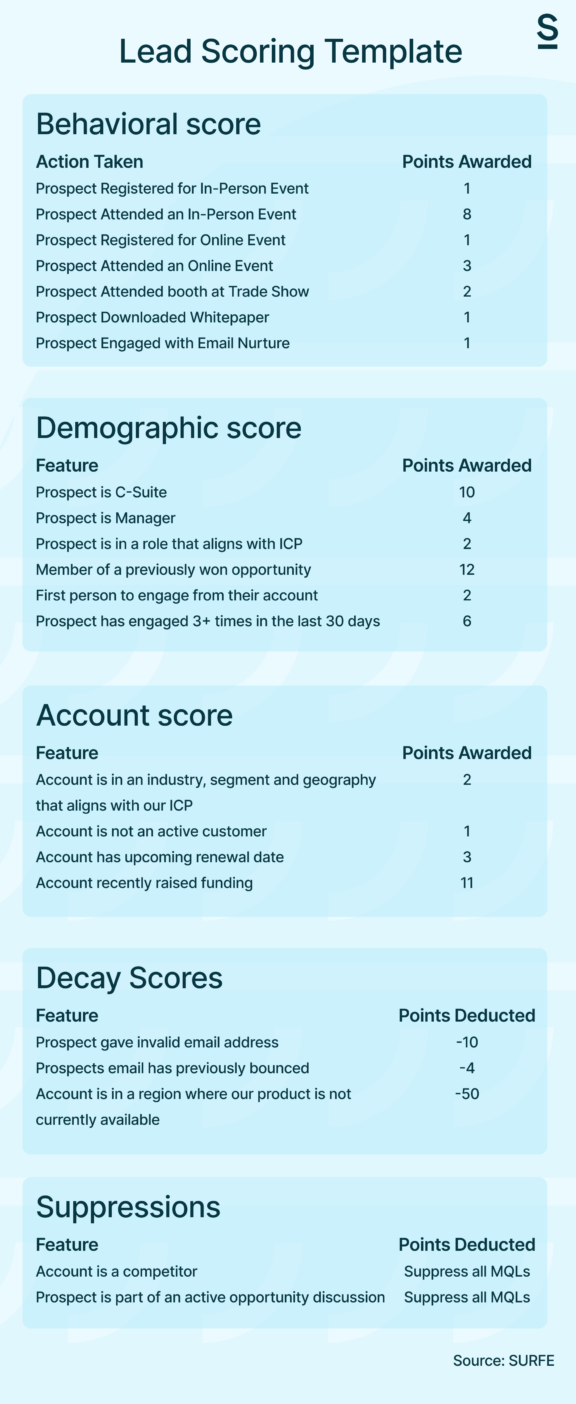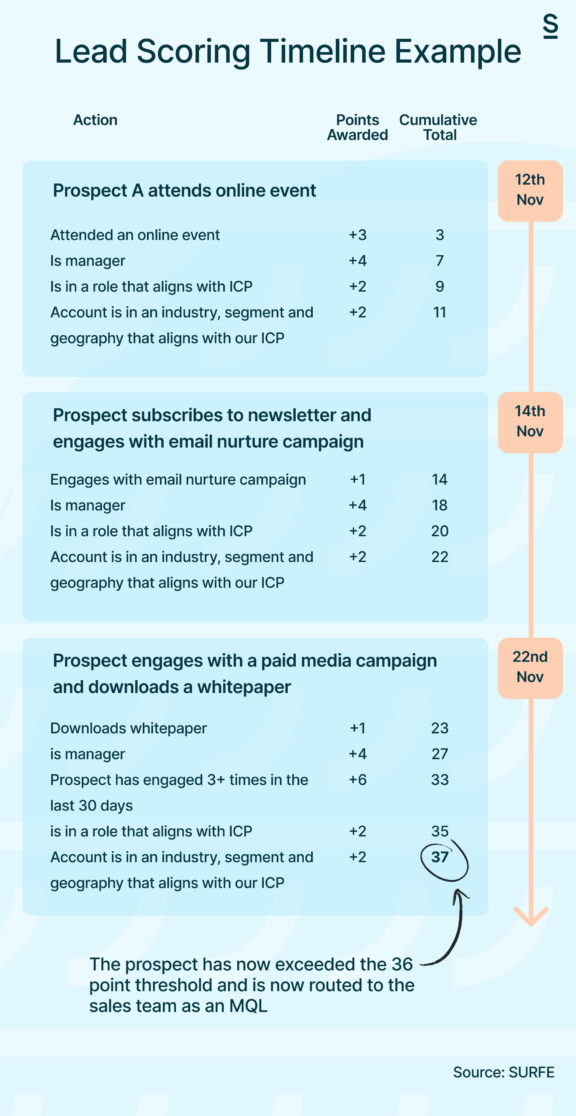What is an MQL?
A Marketing Qualified Lead (MQL) is a prospect who has shown interest in a company’s products or services through interactions with marketing. These leads are considered “warm” and marketing has deemed them ready for a sales conversation. There is the expectation that a higher than average percentage of these prospects will convert into opportunities and paying customers.
How does a lead become an MQL?
Marketing teams are constantly working to educate and engage potential customers. There’s a number of channels they use to do this including Paid Media (advertising), Events, Blogs, Trade Shows, Newsletters and more.
Marketing teams monitor these interactions and identify prospects with a high likelihood of purchasing. When a lead meets the certain criteria, indicating significant interest, marketing alerts the sales team. The sales team then reaches out to these leads to try and secure a deal.
The goal of an MQL is to help sales teams focus their efforts on leads with the best chances of conversion.
How To Identify Marketing Qualified Leads
Every company has its own criteria for what qualifies as an MQL, but the fundamentals are the same: you’re looking for prospects who have shown interest in your products and have a higher-than-average chance of becoming paying customers. If you were to look at the opportunity conversion rates from both Cold Outbound and MQLs, MQLs should convert to opportunities at a higher rate. Intuitively this makes sense, a prospect who attends your event, reads your whitepaper, and subscribes to your newsletter is likely more interested and further along in the buying process.
Determining MQL Criteria
1. Analyse Existing Opportunities: Look at traits and characteristics that signal why they became opportunities. It’s important to analyse the prospect state before the opportunity was created as you’re ultimately trying to answer the question “If I wanted to find other prospects like this one, what would they look like?” Consider:
- Common Traits: What do these customers have in common?
- Engagement Trends: Did they all attend an event, sign up for your newsletter, or research specific parts of your website?
- Negative Signals: Are there traits that reduce the chance of converting to an opportunity or always result in a lost deal?
2. Demographics: Basic demographic features include the prospect’s role, seniority, and location. For more advanced use cases you could include information on recent promotions or job changes, as people in new roles often drive change where your product could be beneficial.
3. Account Information: Key data points should include account segment, industry, and geography. For existing customers include information about existing product usage and spend. Advanced criteria might consider new product launches or recent funding events, as startups with fresh capital or companies with new products often have ambitious growth plans.
4. Historical Behavior: Look for trends in previous engagements, focusing on the type and frequency of interactions. Different marketing activities suggest different levels of interest.
As an example, consider two marketing engagements; Prospect A travels to your office for an in-person event and the second Prospect B who engages with an email nurture campaign. Prospect A has taken significant time out of their day, travelled across town and spent multiple hours listening to one of your presentations. Prospect B has only clicked a link on an email. Prospect A has obviously demonstrated a significantly higher level of intent.
5. Decision-Making Signals: Identify signals that suggest a prospect is a decision-maker, such as their involvement in past opportunities.
Lead scoring
Lead Scoring is a process underlying MQLs. This system assigns numerical values (points) to various actions and characteristics of the lead, the number of points awarded should correlate with your analysis of existing opportunities, where traits that increase the likelihood of opportunity creation are given more points. Points are cumulative across the customer journey and once a prospect accumulates a predetermined number of points they’re classified as an MQL and passed to sales for engagement.
It’s worth noting that certain engagement types will bypass lead scoring and automatically trigger an MQL, for example a contact sales or demo request where the customer has explicitly asked for someone to contact them.
An example lead scoring framework could be:

Helping Sales Teams Find New Leads

Now, let’s take a look at how a prospect could be scored based on this system.
In this example, let’s assume the MQL threshold is 36 points.
Prospect A is a Sales Manager in a greenfield account. The account has 3,000 employees and is in the Technology sector. Both the prospects role and the account are within the ICP.

Which teams decide on MQL processes?
MQL process decisions should be cross-functional and require the input of:
- Marketing : who will be driving customer engagements
- Sales : who will be responsible for customer follow up
- Analytics / BI : who will conduct necessary analysis work
- RevOps : who have an interest in maximising revenue generation
The benefits of MQL lead scoring
A well structured MQL lead scoring process has the following benefits:
- Enhanced Sales Efficiency: Helps sales teams prioritise leads with higher potential, allowing them to focus their time on the most promising prospects.
- Improved Alignment: Increases alignment between Marketing and Sales by jointly defining the criteria for good leads and agreeing on where marketing efforts should be concentrated.
- Better Resource Allocation: Ensures that marketing resources are used effectively to engage leads that are more likely to convert.
- Data-Driven Decisions: Utilises insights from Analytics/BI to continuously refine and improve lead scoring criteria, making the process more accurate and effective over time.
- Increased Revenue Potential: By focusing marketing spend and sales resources on high-potential leads.
Lead Routing – How MQLs are assigned to Sales
Marketing Qualified Leads are handed over to Sales through the Lead Routing process. Lead Routing can be broken down into three distinct components:
- Enrich prospect information
- Assign the right salesperson
- Provide information for follow up
Enrich prospect information
Before passing an MQL to sales the prospect’s information should be enriched with key details. This includes their job title, company description, industry, and up-to-date B2B contact information such as email address and phone number.
Enriching MQL data reduces the chance of your sales teams engaging with out-dated contact data, increasing the likelihood of converting leads into customers.
Assign the right salesperson
The system used to determine where to route an MQL depends on your organisational structure, some common approaches are:
Pooled Resourcing
How It Works: All MQLs are placed into a shared queue. Salespeople work through these leads on a first-in, first-out basis.
Best For: Sales teams targeting the SMB sector or companies where salespeople do not have specific account lists.
Account Assignment
How It Works: Each salesperson is responsible for a specific list of accounts (also known as a Book of Business). MQLs are assigned to the salesperson managing the relevant account.
Best For: Larger enterprise and corporate segments, where building and maintaining relationships is crucial. This ensures that all MQLs from a given account go to the same salesperson, fostering consistency and knowledge.
Geographical or Product Specialization
How It Works: MQLs for certain geographies or where the prospect has demonstrated interest in a specific product are routed to a certain salesperson(s)
Best For: Companies with a diverse product range or where specialised knowledge is crucial for effective selling
Performance-Based Routing
How It Works: During MQL scoring, MQLs are given an additional rating that grades them on their potential for opportunity creation. The highest-potential leads are then assigned to the top-performing salespeople.
Best For: Maximizing revenue and incentivizing the best sales people
Provide information for follow up
For an effective follow-up, the salesperson needs a deep understanding of the customer, their interests, and how to position the company’s solution to win the deal. During the Marketing to Sales handoff, MQLs are typically provided with information to assist the sales person. Lead Routing typically includes information describing:
- Why the Prospect Became an MQL: Insight into what made this lead qualify as an MQL.
- Marketing Engagements: A summary of the marketing activities the prospect has participated in.
- Product Suggestions: Recommendations on which products may be most suitable based on the prospect’s interests and needs.
- Offers or Deals: Information on any relevant offers or deals that could help close the sale.
What is the difference between an MQL and an SAL?
A Marketing Qualified Lead (MQL), this is a prospect who has engaged with marketing and whom marketing believies has shown enough interest that they’re ready for a sales conversation. An SAL is an MQL that has been reviewed and validated by the sales team. Sales accepts the lead as worthy of follow-up, confirming that they meet the criteria for a potential sales opportunity.
Working an MQL
Research
When you receive a Marketing Qualified Lead (MQL), start by researching the customer. Begin with the marketing handoff notes that are usually attached to the MQL, paying close attention to why this prospect is considered sales-ready. Review their engagement history, noting any events they attended or materials they consumed. This information not only helps you find conversation starters but also offers clues about which products they might be interested in and why.
Deepen your understanding by researching their company. Look for recent news or big announcements that might indicate why they are interested in your solutions. Also, research the individual’s role and tenure in the company. LinkedIn is a valuable resource, especially if the prospect is an active poster, as their content can provide insights into their interests and needs.
Prospect
Best practice says that MQLs should be engaged within a few hours of the customer engagement. But in reality the time to follow up varies depending on the type of engagement:
|
Engagement Type |
Typical SLA |
|
Contact Sales Request |
<4 hours |
|
Demo Request |
<4 hours |
|
In Person Event |
Next day |
|
Online Event |
48 hours |
|
Paid Media Engagement |
48 hours |
| Nurture Engagement |
4 days |
When working an MQL, build a multi-touch, multi-channel engagement strategy. Typically, fewer touchpoints are needed compared to cold outbound efforts, as the prospect already has some connection to your company. At a minimum it is recommended that each MQL receives at least 7 touchpoints before recycling.
Craft a message that grabs their attention and resonates with them. Start by calling the prospect, and if you can’t connect, quickly follow up with a LinkedIn connection request and an email. Reference their previous actions in your follow-up messages, such as, “Hi [First Name], I think I missed you yesterday at our [Event Name] event. I hope you found the sessions useful. For me, the biggest takeaway was [insert value]…”
Qualify
Use a structured framework to ensure prospects are properly qualified. The most popular qualification framework is BANT:
- Budget: Determine if the lead has the financial resources for your product or service.
- Authority: Identify if the lead has the decision-making power or is an influencer in the buying process.
- Need: Understand if there is a genuine need for your product or service.
- Timeline: Assess the lead’s timeframe for making a purchase.
MQL best practices
- Prioritise Contact Sales requests – A prospect who has explicitly asked to speak to sales is a hot-lead. This interest may fade if they find an alternative solution, engage these prospects within a few hours to increase the chances for opportunity creation.
- Iterate on your Lead Scoring model – Treat your lead scoring model as something that evolves, update signals and scores when as you learn.
- Use structured cadencing to work MQLs more efficiently – Not all MQLs will convert at the same rates, typically MQLs convert at anywhere between 3% and 30%. It is best practice to bucket MQLs into High, Medium and Low potential categories. Those in the High potential category should receive fully personalised follow-up, but creating a cadence custom to each prospect is time consuming, it may be more feasible to engage Low potential MQLs with pre-build cadences. These cadences may be created by the marketer, for example an event marketer may create a follow up cadence that sales can use to engage prospects who attend the event.
- Maintain Communication – Sales and Marketing must communicate frequently to maintain alignment, Sales should have a regular channel for sharing feedback on MQL quality and Marketing should regularly share details of upcoming campaigns
Metrics used to measure MQL performance
MQL to SAL Rate
Measure the percentage of MQLs that get accepted by Sales. MQLs should be of high quality that a majority of MQLs are accepted. Typically this should be above 90%.
Lead to Opportunity Rate (LTO)
The percentage of MQLs that convert to opportunities
Opportunity Creation
The number or percentage of prospects who are successfully qualified and turn into opportunities.
Follow Up Effort
Follow-Up Effort measures how diligently the sales team is engaging with Marketing Qualified Leads (MQLs). It is calculated as the average number of contact attempts made per MQL.
Time to Follow Up
The average time between MQL creation and the first sales touchpoint.
Opportunity Velocity
The speed at which MQLs move through the sales pipeline.
Closed Deals
The number or percentage of MQLs that ultimately convert into revenue.
Return on Investment (ROI)
ROI measures the efficiency and profitability of your marketing efforts. It is calculated by dividing the total revenue generated from Marketing Qualified Leads (MQLs) by the total marketing costs incurred to generate those MQLs.
MQL FAQ’s
Why don’t all prospect engagements become MQLs?
Not all prospect engagements become MQLs because not all interactions indicate a significant level of interest or readiness to purchase. Marketing teams set specific criteria for what qualifies as an MQL based on factors like engagement level, demographic fit, and past behaviors. Prospects who don’t meet these criteria are not considered ready for sales follow-up and therefore do not become MQLs.
What are the best marketing channels for MQL creation?
The best marketing channels for MQL creation include:
- Paid Media (Advertising): Attracts a wide audience and can be targeted to specific demographics.
- Events: Both in-person and online events engage prospects deeply and generate high-quality leads.
- Blogs and Content Marketing: Establish thought leadership and attract prospects interested in your industry.
- Newsletters (and other email outreach): Keep prospects informed and engaged with regular updates.
- Social Media Campaigns: Engage and nurture prospects through social platforms.
What is the best tool to enrich MQL data?
There are several tools available to enrich MQL data, each offering unique benefits:
- Clearbit: Provides detailed company and contact information, including firmographics and technographics.
- ZoomInfo: Offers a comprehensive B2B database with contact and company information.
- LinkedIn Sales Navigator: Allows for detailed insights and data about prospects’ professional backgrounds and activities.
- HubSpot: Enriches contact records with information from its extensive CRM and integrates well with other marketing tools.
- Surfe: Enriches the contact info of your LinkedIn contacts and automatically syncs it with your CRM.
What are some common pitfalls to avoid when routing MQLs to sales teams?
When routing MQLs to sales teams, avoid these common pitfalls:
- Incomplete Data: Ensure that all necessary contact and engagement information is complete and accurate before passing leads to sales.
- Poor Lead Assignment: Avoid using inefficient or unclear lead assignment methods. Use structured approaches like account-based assignment, geographical specializations, or performance-based routing.
- Lack of Follow-Up Information: Provide detailed notes and insights about why a lead qualifies as an MQL, including their engagement history and potential interests.
- Delayed Handoff: Ensure MQLs are handed off to sales promptly to capitalize on their interest.
- Insufficient Training: Ensure sales teams understand the MQL criteria and how to effectively follow up with these leads.
- Inadequate Feedback Loops: Establish regular communication channels between sales and marketing to refine the MQL criteria and lead scoring processes based on feedback and performance.

